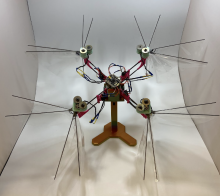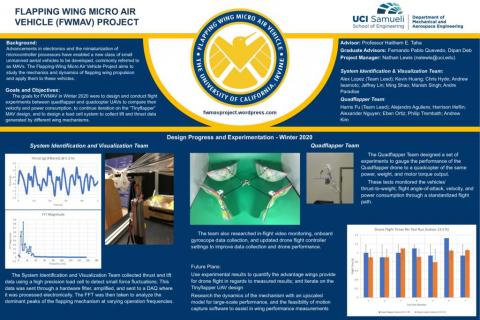Flapping-Wing Micro Air Vehicle (FWMAV)
Summary
In recent history, humans have discovered and constructed the mechanism of flight. As far as technologies have advanced, flying birds and insects still outperform the agility, maneuverability, and stability of man-made aircraft. The Flapping Wing Micro Air Vehicle research team works to unlock the secrets of how Mother Nature does flight. For example, hummingbirds and dragonflies demonstrate remarkable aerial control during flight and are capable of traversing complex environments.
FWMAV studies the phenomenon behind the flapping wing. Animals and insects that use flapping mechanisms to fly demonstrate remarkable aerial control during flight, capable of traversing complex environments. FWMAV's research focuses on flight mechanisms and physical phenomena. Engineers examine the flight patterns of birds and insects so they can design efficient flight mechanisms. Different forms of fluid computation and force analysis were performed on FWMAVs to learn about the complex unsteady aerodynamics associated with the flapping motion of the wings. The small size, agility, and ability to hover allow FWMAV to have numerous applications in the field of law enforcement and the military as well as aerial research in the scientific field.
The purpose of this project is to investigate the physical phenomena behind FWMAV and create applications of such phenomena. FWMAV utilizes unsteady aerodynamics and nonlinear flight mechanism to achieve its aerial capabilities. In order to identify and try to understand the physical aspects of FWMAVs, which produce excellent flight control, various designs must be investigated.
FWMAV is divided into four teams: Alpha Drone, Beta Drone, Mechanical Comparison, and Novel Mechanism Design. The Alpha Drone team is responsible for iterating on the current design of the drone. This entails using stock materials to develop the drone, including off-the-shelf hardware and prebuilt flapping mechanisms while continuing to test and improve the design. The Beta Drone team is responsible for iterating on the current Beta Drone design and fabricating a flying quadflapper drone. This entails choosing a new outrunner motor, redesigning the chassis and consequent components to securely fit the chosen outrunner motor, soldering all necessary electronic components, setting up the transmitter and receiver, configuring the flight controller via betaflight, as well getting the propeller drone functional once again for testing and mechanical comparison. The Mechanical Comparison team is responsible for designing and assembling modified clap angles for a double clap and triple clap wing mechanism (from a range of 0 to 20 degrees), then testing these assembled clap angles using LabVIEW to find an optimal clap angle to use for our drones. The novel mechanism design team is responsible for applying Professor McCarthy’s concepts of the Jansen wing robotics linkage and designing it into a functional prototype.
Advisor
Dr. Haiethem Taha
hetaha@uci.edu
Management Team Members
Kevin Huang - Project Manager
https://www.linkedin.com/in/kevinhuanght/
Dipan Deb - Graduate Advisor
https://www.linkedin.com/in/dipan-deb-81a731154/
Vincent Ton - Team Lead
https://www.linkedin.com/in/vincentvinhtienton/
John Williams - Team Lead and 3D printing advisor
https://www.linkedin.com/in/john-williams-a77292160
Sub Group Team Members
Alpha
- Ethan Bagnas
- Dylan Nguyen
- Khashayar Valisharifabad
- Victor Plesco
- Vincent Ton
Beta
- Jason Hillyer
- Michelle Manku
- Mary Ajemyan
- Caden McCarthy
- David Dlugopolski
Mech Comp
- Aaron Schmidt
- Jeremy Rose
- John Williams
Novel
- Shobit Brijesh
- Nedy Abisaab


